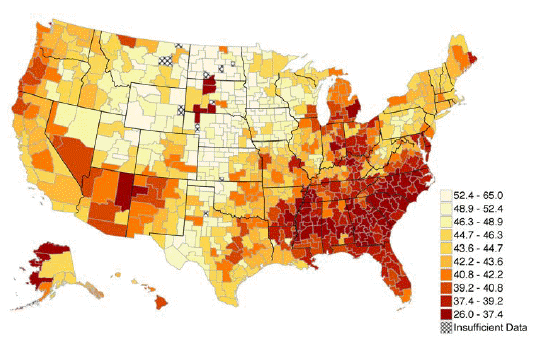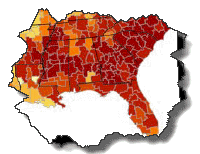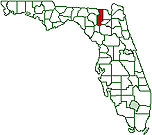Florida - One of the Top States In Income Inequality & Lack of Upward Financial Mobility For African Americans
Florida and Southeast U.S. Lead Nation In Poverty Stagnation
Posted February 03, 2014 08:55 am

This map shows the average percentile rank of children
who grow up in below -median income families. Darker
colors represent areas where children are less likely to
move up. +++ Click to enlarge
FLORIDA – A recent study titled, "Where Is The Land Of Opportunity? The Geography of Intergenerational Mobility In the Unites States," points a damning finger at Florida. The study found that African Americans have less than a 6% chance for upward financial mobility, while Jacksonville's African American children rank #4 in the nation in the lack of financial mobility. The study found that the leading causes of poverty stagnation are: segregation, income inequality, local school quality, social capital, and family structure.
The study's authors, from Harvard and Berkley, analyzed records on the incomes of "more than 40 million children and their parents."
America, the land of opportunity?

Florida and the southeast lead the nation in poverty
stagnation.
The report questions the widely held belief that the United States is the "land of opportunity," where a child's success depends little on family background. The authors found that the U.S. is better described, "As a collection of societies, some of which are lands of opportunity" with high rates of mobility across generations, and others in which few children escape poverty."
The report identified segregation as the first factor strongly related to upward mobility and stated, "Areas with larger black populations tend to be more segregated by income and race, which could affect both white and black low-income individuals adversely."
The author's research suggested that income inequality is caused by the erosion of the middle class.
K-12 school quality
Link:
Where is the Land of Opportunity? The Geography of
Intergenerational Mobility in the U.S.
Raj Chetty, Nathaniel Hendren,
Patrick Kline, Emmanuel Saez
K-12 school quality also was found to be a factor in the rates of upward mobility. Not surprisingly, areas with higher test scores, lower dropout rates, and smaller class sizes, and areas with higher local tax rates, which are predominantly used to finance public schools, have higher rates of upward mobility.
High upward mobility areas tend to have higher fractions of religious individuals and greater participation in local civic organizations.
The study found, "The strongest predictors of upward mobility are measures of family structure, such as the fraction of single parents in the area. As with race, parents' marital status does not matter purely through its effects at the individual level. Children of married parents also have higher rates of upward mobility if they live in communities with fewer single parents."
The authors found, "Modest correlations between upward mobility and local tax and government expenditure policies and no systematic correlation between mobility and local labor market conditions, rates of migration, or access to higher education.
Drilling through the report, its charts, links, and statistical spreadsheets, one finds that Florida's African American children are condemned to poverty, of which a leading factor is the income status of the child's parents.
In Florida, minorities account for 73% of all poverty.
Between 2007 and 2009, Florida saw an increase of 550,000 people in poverty.
Florida has 2.7 million people in poverty and 1.7 million people living in "deep poverty," defined by the US Census Bureau as households with incomes of 50% or less of the federal poverty level. That amounts to $5,478 a year for an individual.
The report found that while a child born in the bottom fifth of the income distribution has a 7.8% chance of reaching the top fifth in the U.S. as a whole, in some places, such as Salt Lake City and San Jose, the chance of moving from the bottom fifth to the top fifth is as high as 12.9%.
On the other hand, in places like Charlotte and Atlanta, it is as low as 4.4%. Jacksonville came in 6th from the bottom out of 50 cities measured at 4.9%.
The authors concluded, "The variation in upward financial mobility is strongly correlated with five factors: (1) residential segregation, (2) income inequality, (3) school quality, (4) social capital, and (5) family structure."
In a related study, the authors challenged popular perception: "Contrary to popular perception, economic mobility has not changed significantly over time; however, it is consistently lower in the U.S. than in most developed countries."
